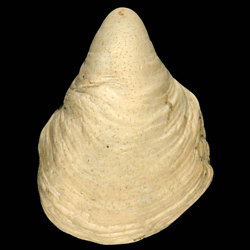
Hipponicidae

- Phylum: Mollusca
- Class: Gastropoda
- Order: Littorinimorpha
- Family: Hipponicidae
Overview
Key morphological features: The Hipponicidae are small, limpet-like gastropods (< 30mm) with thin, cap-shaped shells. They also secrete a calcareous base onto the substrate on which they live. The shell has a spiral protoconch, but the spire is very small relative to the body whorl. The shell exterior can be smooth or ornamented with radial cords or commarginal lamellae. The aperture is wide and subcircular in outline, and the interior features a thin projection of shell—shaped like half of a cone and U-shaped when viewed from the aperture—that extends from the apex towards the aperture. Source: Davies, A.M. 1971. Tertiary Faunas Vol. 1, second edition. New York: American Elsevier Publishing Company, Inc. 571 pp.; Tunnell Jr., J.W., Andrews, J., Barrera, N.C., Moretzsohn, F. 2010. Encyclopedia of Texas Seashells. College Station: Texas A&M University Press. 512 pp.
Geological range: Upper Cretaceous to Recent (Davies, 1971).
Geographic distribution: A distributional map for modern Hipponicidae may be accessed from OBIS. A distributional map for ancient Hipponicidae may be accessed from the Paleobiology Database.
Diversity: There are 44 recognized living species of Hipponicidae and 9 genera (WoRMS database, unvetted). The Paleobiology Database recognizes 10 fossil genera and 83 fossil species of Hipponicidae (unvetted).
Paleoecology: The Hipponicidae are sessile, epifaunal, deposit feeding, marine gastropods. They live on hard substrates, including the shells of other gastropods. They can be found in warm waters worldwide at depths ranging from the low intertidal to the continental slope. Source: Tunnell et al. (2010).
Phylogenetic status: Unknown.
